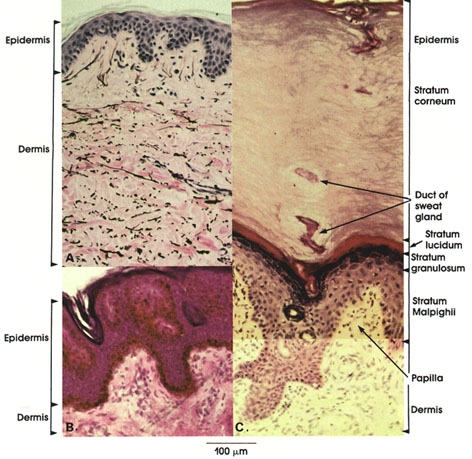

Ronald A. Bergman, Ph.D., Adel K. Afifi, M.D., Paul M. Heidger,
Jr., Ph.D.
Peer Review Status: Externally Peer Reviewed

Human, 10% formalin,
A. Pinkus' acid orcein-Giemsa method,
B. and C., H. & E., 162 x.
This plate shows the structural variation of the epidermis in different parts of the body.
The epidermis in all three areas is keratinized stratified squamous epithelium. The thickness varies from one site to the other. Note the marked thickness of the epidermis in C (palm). The epidermis of palms of the hands and soles of the feet is the thickest in the body. In these regions only four layers of the epidermis are well delineated.
Stratum Malpighii: Named for Marcello Malpighi, 1628-1694, the Italian anatomist and founder of histology who described this layer. This layer is responsible for the proliferative activity of the epidermis. Cells in this layer are connected by intercellular bridges. See Plate 137.
Stratum granulosum: Cells in this layer are deeply stained and rather flattened. This stratum is thin in most parts of the body. Nuclei are pyknotic (inactive), and cytoplasm contains keratohyalin granules.
Stratum lucidum: Usually seen only in thick epidermis of palms and soles. It appears as a homogeneous translucent layer in which cellular outlines are indistinct and nuclei are not seen.
Stratum corneum: A layer of cornified cells that are closely packed, flat, and anucleate. They contain keratin. Thickness of this layer varies in different regions of the body and is thickest in the palms and soles. The superficial layer is shed continuously.
Dermis: A layer of dense connective tissue underlying the epidermis. It varies in thickness in different body regions. Note the thick dermis in the shoulder skin (A).
Papilla: A projection of dermis between epidermal pegs. Particularly abundant in the soles and palms.
Duct of sweat gland: This is seen spiraling through the stratum corneum of the epidermis to open at its free surface.
Next Page | Previous Page | Section Top | Title Page
Please send us comments by filling out our Comment Form.
All contents copyright © 1995-2025 the Author(s) and Michael P. D'Alessandro, M.D. All rights reserved.
"Anatomy Atlases", the Anatomy Atlases logo, and "A digital library of anatomy information" are all Trademarks of Michael P. D'Alessandro, M.D.
Anatomy Atlases is funded in whole by Michael P. D'Alessandro, M.D. Advertising is not accepted.
Your personal information remains confidential and is not sold, leased, or given to any third party be they reliable or not.
The information contained in Anatomy Atlases is not a substitute for the medical care and advice of your physician. There may be variations in treatment that your physician may recommend based on individual facts and circumstances.
URL: http://www.anatomyatlases.org/